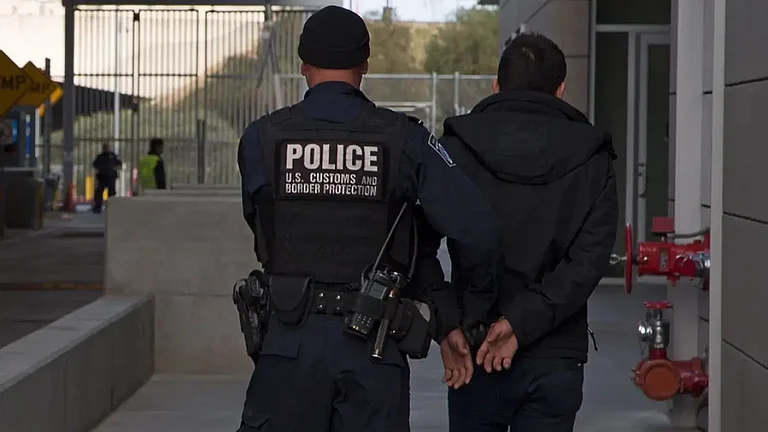The question of the origin of Covid-19 continues to plague scientists and world leaders even three years after the virus first emerged in China.
Despite three years and highly polarised debates, there is no conclusive evidence linking SARS-CoV-2, the virus causing Covid-19 disease, to any source.
For much of the first year of the Covid-19 pandemic, much of the scientific as well as media communities were closed to the idea of a laboratory origin of Covid-19. Three years later, however, scientists as well as world leaders are actively calling for an investigation of a possible natural as well as laboratory origin of Covid-19.
A recent study, uploaded on the internet as a pre-print paper, has revived the debate as it has suggested that the coronavirus causing Covid-19 was synthesised in a laboratory.
Here we explain what the pre-print says, why it's being treated with skepticism, and the broader case for lab origin of Covid-19.
What the pre-print says?
A recent pre-print —a study yet to be peer-reviewed— claims to have identified possibly unusual sequence patterns in the SARS-CoV-2 genome. These patterns may indicate the virus was genetically modified in a lab.
The preprint has been poorly received by most experts in the field, with many reacting to it on social media.
Vox explains that everything made out of RNA —including SARS-CoV-2— is made up of strings of four nucleotides: adenine (A), uracil (U), guanine (G), and cytosine (C). The genome of the virus is therefore made of several strings of these four letters, several of which are repeated throughout the genome.
The pre-print's main assertions are made on strings that are called "restriction sites".
Vox explains, "When researchers are conducting lab work on viruses, they take advantage of certain short strings, called restriction sites, that appear repeatedly in the genome. Those strings will bind to certain enzymes the researchers use to cut and glue segments of the virus, which enables them to assemble whole genomes from short sequences, swap out different sequences to study different things, and more."
The pre-print claims that in the SARS-CoV-2 genome, the distribution of some restriction sites —the spots where the genome may have been cut and joined— is "anomalous" and compatible with the virus having been stitched together from multiple smaller fragments using certain enzymes called IIS enzymes.
Notably, the restriction sites displayed an excess of silent mutations. These are nucleotide changes that don’t affect the characteristics of the virus and can be hallmarks of genetic engineering.
Why are experts rejecting these claims?
The pre-print's claims have been mostly rejected because it has been pointed out that such sites are not necessarily unnatural.
The mathematical calculations behind the claims have also been questioned.
Vox explains, "Viruses recombine with each other constantly, sharing chunks of their genetic code each time. Each of the restriction sites identified in the paper is present in other SARS-CoV-2-like coronaviruses researchers have identified in the last few years. Critically, the sequences around the restriction site in SARS-CoV-2 also tend to match the surrounding RNA in the other coronaviruses —suggesting that the whole segment was lifted into SARS-CoV-2 all at once."
Questions have also been raised around some of the mathematical metrics on which the authors’ conclusions are based, in particular the presumed maximum length of the individual viral fragments. Meanwhile, the analysis has been criticised because it considered only the two type IIS restriction enzymes commonly used in this context.
All of these extremely technical points of contention illustrate the difficulty of formulating satisfying, testable hypotheses for complex questions.
The case for Covid-19 lab origin
A lab-origin refers to an accidental leak of the virus from a lab. It does not mean SARS-CoV-2's intentional leak as a biological weapon.
The location of the initial outbreak close to the Wuhan Institute of Virology (WIV) drew suspicion that it may have been a lab leak. But scientists largely came out in favour of a natural spillover from bats to humans, through an intermediate animal host, at the Huanan seafood market located a few kilometres away. To date, though, no immediate ancestor of SARS-CoV-2 has been found in bats nor in any other animal that was on sale at the market.
It should be emphasised that any realistic lab origin scenario would point to an accidental escape, and not to any nefarious intent. Viruses have no application as bioweapons in the modern world. They’re difficult to produce in large quantities and to deploy. They take days to be effective, and if capable of human-to-human transmission, they’re likely to spread to unintended populations, including friendly forces.
The lab-origin thesis rests on what's called 'gain of function' research by the Chinese and their foreign collaborators. The gain of function research refers to the process of a virus being made more lethal through experiments in a lab. It is now known that WIV in Wuhan, where Covid-19 first emerged, was engaged in such research for several years.
Moreover, the absolute opacity from China along with misinformation campaign by its government has also added to suspicions. Instead of making data public and promoting scientific investigations, China closed its databases, hid the information known, and covered up years of research and scientific information that could have helped the world prepare better for the pandemic.
What we know of lab-origin probe so far?
Earlier this year, the World Health Organization (WHO) reversed its position of almost two years and opened the possibility for Covid-19's lab-origin.
After over two years of the first coronavirus outbreak in China and after at least 6.3 million deaths have been worldwide, the WHO in a report released in June said "key pieces of data" to explain how the pandemic began were still missing. The scientists said the WHO would "remain open to any and all scientific evidence that becomes available in the future to allow for comprehensive testing of all reasonable hypotheses".
In simpler words, unlike before, a lab-origin is not ruled out. The WHO said more research is needed on this line of research.
Here is the case against Chinese researchers
Of hundreds of coronaviruses, only seven including SARS-CoV-2 causing Covid-19 affect humans. The Chinese were working on a wide range of coronaviruses in their labs. This included gain of function research.
To understand the extent of the kind of research, take this case: In 1990s, Ralph Baric and Boyd Yount of the University of North Carolina "trained" a mice coronavirus to infect hamsters, which means they made the virus infect a species that it wouldn't have infected naturally. They altered the nature of the virus to infect an entirely new specie.
Cover-ups of Chinese coronavirus research
The Chinese were collecting coronavirus samples and researching on them in Wuhan since at least 2010. WIV's Shi Zhengli, called 'Bat Woman' for her research on bat viruses, and her American collegue Peter Daszak published an account of 630 coronaviruses sampled between 2010-15.
Earlier in the pandemic, Zhengli wrote that Sars-CoV-2 closely resembled an earlier virus called RaTG13. But she didn't share much about it.
It was an Indian open-source investigator who unearthed that WIV had found RaTG13 in China's Yunnan province, as per Newsweek. The Indian investigator, who goes by the pseudonym The Seeker, found that the "genetic sequence for RaTG13 perfectly matched a small piece of genetic code posted as part of a paper written by Shi Zhengli years earlier, but never mentioned again".
Experts, including scientists Alina Chan, science writer Matt Ridley, and others, spent hours searching online for RaTG13, which was 96.2 per cent similar to SARS-CoV-2. Later, it emerged that the Chinese had renamed RaTG13 as Bt-CoV/4991 in their records, which meant that unless someone looked very carefully, no one would draw the link. This meant that the Chinese had the closest ancestor of the virus causing Covid-19 in their lab for years, were aware of it, and they deliberately kept this information from the world.
Later findings would further put a question mark on Chinese researchers.
Where did the closest ancestor come from?
The RaTG13 virus came from a mine in China's Mojiang in Yunnan province. Six miners cleaning bat guano in Mojiang fell ill and three of them died.
The Seeker found a Chinese student's thesis that described the miners' illness. The thesis said the illness was "caused by SARS-like [coronavirus] from the Chinese horseshoe bat or other bats". This thesis, and another thesis that The Seeker found, showed that four of these miners had tested positive for SARS-like anti-bodies.
When The Seeker shared this information publicly, the Chinese government shut down public access to its databases that had these documents. Note, one of the key arguments for Chinese complicity in the Covid-origin through a lab leak is their opacity and cover-ups, suggesting they have something to hide.
To sum it up, the Chinese knew they had SARS-CoV-2's closest ancestor in their freezers which had caused deaths earlier. They renamed it which meant the world could not draw the connection. When discovered, they shut down their databases.
Later when Zhengli and her American fellow researcher Daszak published the account of 630 coronaviruses they had sampled, the open-source investigators' collective DRASTIC went through them and found eight more viruses closely related to RaTG13 —the closest to SARS-CoV-2— but Zhengli had not flagged it, reported Vanity Fair.
Chinese studied coronaviruses all these years
Newsweek reported that data scientist Francisco de Asis de Ribera discovered that Chinese scientists were working on RaTG13 as late as 2018, adding that they made at least seven trips to the mine where the virus was discovered in Mojiang in Yunnan province to collect thousands of samples.
Vanity Fair's Katherine Eban reported, citing US State Department sources, that "three researchers at the Wuhan Institute of Virology, all connected with gain-of-function research on coronaviruses, had fallen ill in November 2019 and appeared to have visited the hospital with symptoms similar to Covid-19".
The first suspected case of Covid-19 emerged in China on 17 November 2019 and the first confirmed case on 1 December, according to a timeline by scientist Chan and science writer Ridley in their book VIRAL:The Search for the Origin of Covid-19. This information in addition to the fact that Chinese had not one but nine viruses very closely related to SARS-CoV-2 for years and they did not disclose it to the world poses further questions.
Katherine put it like this, quoting a US official: An institute funded by American dollars [as WIV was working on American government grants] is trying to teach a bat virus to infect human cells, then there is a virus in the same city as that lab. It is not being intellectually honest not to consider the hypothesis of a lab escape.
The question of burden of proof
While a number of epxerts have questioned the lab-leak hypothesis for its lack of "smoking gun" evidence, people pursuing this line of investigation stressed while there is no smoking gun for lab-origin, there is none for natural-origin as well. Even now, no one knows for sure which animal first infected humans — if it did at all.
Moreover, experts stress that they are not saying that the virus emerged from a lab. They stress that they are looking for and are presenting the evidence and are only pushing for an investigation for such a possibility.
However, after such a large body of evidence documenting Chinese research on viruses and cover ups, Alina and Matt in their book VIRAL wrote that the burden of proof should be on those advocating a natural origin.
They noted: "Much of the debate about the origin of the virus assumes that the laboratory-leak theory must prove itself. Natural spillover, by contrast, is the default assumption, which does not have to prove anything."
Alina and Matt added that the ball is now in the opponent's court.
They wrote: "Given the powerful circumstantial evidence that Wuhan was not a particularly likely place for a natural epidemic of a SARS-like virus to begin, but an obvious one for a laboratory-leaked one to start [because it has WIV that was researching on coronaviruses for years], it is surely reasonable to expect both hypotheses to be put to a similarly rigorous test."
While in the book, Alina did not take a side, evidence unearthed after the publication of the book made her tilt towards the lab origin of a virus.
"However, in late 2021, when more information emerged about research in Wuhan, my judgment is that the evidence now points more strongly towards a lab origin," said Alina in January.
(With inputs from the The Conversation via PTI)


























